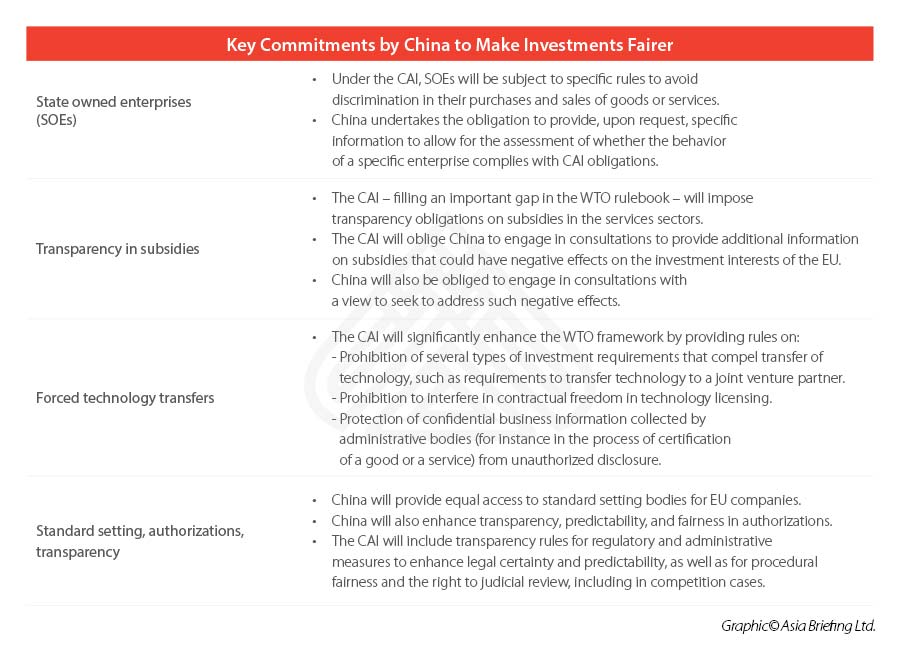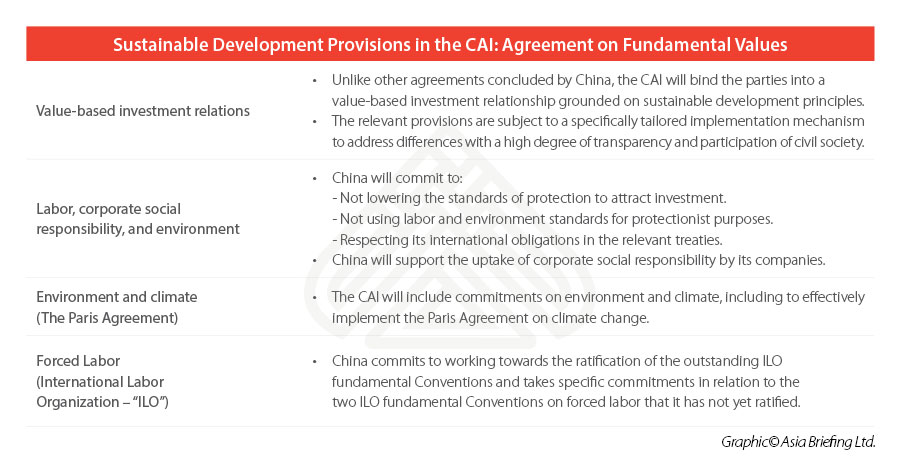EU, China Reach Agreement on Investments in Principle: What Does it Mean for Businesses
On December 30, after seven years of negotiations and despite the uncertainties related to US-China ties that could have slowed down the negotiation process, the EU and China were able to conclude a deal in principle on investments. The Comprehensive Agreement on Investments (“CAI”) is the most ambitious agreement that China has ever concluded with a third country.
This agreement followed a call between Chinese President Xi Jinping and European Commission President von der Leyen, European Council President Charles Michel, and German Chancellor Angela Merkel on behalf of the Presidency of the EU Council, as well as French President Emmanuel Macron.
The parties to the CAI appear aligned on key milestones and principles that the agreement will regulate. This means that China has committed to a greater level of market access for EU investors, including ensuring fair treatment for EU companies so they can compete on a more level playing field in China. Towards this, the has CAI notified China’s obligations in the treatment of state-owned enterprises (SOEs), transparency of subsidies, and rules against the forced transfer of technologies.
Significantly, according to the EU Commission Press, China has also agreed to ambitious provisions on sustainable development, including commitments on forced labor and the ratification of relevant International Labor Organization (“ILO”) Conventions.
The conclusion – in principle – of the CAI negotiations is a turning point in EU- China relations. But this is only the first step of the process; the text of the deal has not yet been finalized and the agreement must be adopted and ratified by all the parties involved.
The outline of the CAI
The EU and China have concluded negotiations and agree to the essential principles that both parties want reflected in the CAI. Such alignment sets the foundation for a strong development of international cooperation and for the increase of bilateral investments and may also boost EU economic growth, especially in the post-COVID-19 recovery period.
The European Commission has issued a document that summarizes the results of the negotiations between the EU and China, remarking that it needs to be considered ad referendum – hence subject to finalization of details and further procedures to be implemented by the parties necessary to be bound by the agreement.
Under the preamble of the above-mentioned document, the parties reaffirm their commitment to the Charter of the United Nations (26 June 1945) – principles articulated in the Universal Declaration of Human Rights (10 December 1948) – and agree to promote investment in a manner that supports environmental protection and labor rights’ protection.
After this, the document reports that the CAI will focus on the following aspects:
- Market access and investment liberalization
- Level playing field (state-owned enterprises, forced technology transfers, transparency in subsidies)
- Domestic regulation
- Transparency in standard setting
- Financial services
- Sustainable development
- State to state dispute settlement mechanism
- Institutional and final provisions
The principles mentioned in the document seem to positively respond to the EU requests upon China, thus paving the way for an unprecedented level of access for EU investors in the China market. EU investors will be allowed to set up new companies in key sectors.
The elimination of quantitative restrictions, equity caps, and/or joint venture requirements in various sectors will level the playing field for EU companies in China, providing rules to discipline Chinese SOE behavior, guaranteeing transparency in subsidies, and facilitating sustainable development.
The CAI, by binding China at the international level, will enhance the protection of foreign investors’ rights and interests that will be guaranteed by the treaty.
In other words, it makes the conditions of market access for EU companies independent from China’s internal policies. Also, the parties to CAI have agreed to establish a dispute resolution settlement mechanism in case of any breach.
How to read the CAI: Key elements
-
China’s market access commitments
At the end of the negotiations, China agreed to open-up several manufacturing industries to EU investors, with limited exclusions – in areas with significant overcapacity. Considering that more than half of EU investment in China is in the manufacturing sector, this is a huge achievement.
More specifically, EU investments in manufacturing are concentrated 28 percent in the automotive industry and 22 percent for basic materials, including production of electric cars, chemicals, telecoms equipment, and health equipment, among others.
Interestingly, China’s market opening commitments in manufacturing include automobiles (traditional and new energy vehicles), production of transport and health equipment, and production of chemicals, among others – thereby satisfying EU investor interests. Also, with reference to services, China’s market opening commitments will affect financial services, international maritime services, environmental, construction, computer services, auxiliary air transport services, cloud services, and private health services.
In the non-services sectors, China is making (limited) liberalization commitments in agriculture, fisheries, mining, and energy.
On the EU side, the market is already open for services sectors under the General Agreement on Trade in Services (GATS). With reference to EU sensitivities, such as energy, agriculture, fisheries, audio-visual, public services – the EU Commission declared that these are all preserved in the CAI.
According to the memo released by the European Commission, we note below some examples of the market access commitments undertaken by China under the CAI.
-
Creating a level playing field
During CAI negotiations, the EU reiterated the necessity of ensuring fair competition on the market. This brought up concerns linked to the power granted to state-owned enterprises (which contribute to approximately 30 percent of China GDP) and the need to regulate their behavior. Further, EU negotiators pointed to the need to ensure transparency in several procedures applicable to foreign investments, including those related to the eligibility for and distribution of subsidies.
Another fundamental concern discussed related to the forced transfer of technologies, for example, in joint ventures, that may cause severe damages to EU investors.
Here below we report the main commitments that China will undertake to make investments fairer, according to the European Commission’s memo.
-
Embedding sustainable development in the EU-China investment relationship
Sustainable development was among the most discussed topics during CAI negotiations due to its vast scope and complexity as well as the different perspectives of the parties. Here the relevance of the CAI is undeniable as this is the first time that China has agreed to such ambitious provisions with a trade partner.
The section on sustainable development involves impact on the economy, society, and environment and the parties reached understanding on some fundamental values, as noted below.
-
Monitoring implementation and dispute settlement
An essential part of the treaty will be the one dedicated to dispute resolution. During the negotiations, the parties considered, both, a state-to-state dispute resolution mechanism and an investor-to-state dispute settlement mechanism (also referred to as Investment Court System – “ICS”).
The EU insisted on the introduction of the ICS because, under the EU perspective, provisions on investment protection should ensure a high level of protection for investors, while preserving governments’ right to regulate.
In this regard, it is worth noting that on the multilateral level, the EU is pursuing the establishment of a Multilateral Investment Court through intergovernmental discussions at the United Nations Commission on International Trade Law (“UNCITRAL”). Once established, the Multilateral Investment Court will replace the existing arbitral tribunal established under current bilateral investment treaties (BITs) and the ICS.
With reference to CAI, EU and China have agreed to modernize protection standards and a dispute settlement mechanism that takes into account the work undertaken to establish the Multilateral Investment Court at the UNCITRAL.
According to the EU Commission press release, the EU and China agreed to complete the negotiations on investment protection and investment dispute settlement within two years of signing the CAI.
So far, the parties agreed to include in the CAI provisions on state-to-state dispute settlement mechanism and an institutional framework to monitor its implementation, that can be summarized as below.
The global context and road to implementation
In 2013, EU-China launched negotiations on the CAI with the aim to provide investors on both sides with predictable, long-term access to the EU and Chinese markets and to protect investors and their investments.
Interestingly, parties were debating on market access and sustainable development as late as the beginning of December 2020. Yet, just days before the end of the year, they managed to conclude talks and come to political agreement – in principle. Germany, an important EU member, was highly committed to securing agreement from China on key provisions that would benefit its companies in China. The EU’s quicker than anticipated agreement – also came in just weeks before the new Biden administration takes over the US presidency (on January 20, 2021). This urgency seemed to indicate the EU’s decision to have more autonomy in how it engages with China, the impact of which could spill over into EU-US relations in the near term.
However, regardless of the speculation, the CAI elicits high expectations from the international business community in the precedents it will set. Once the CAI gets signed and comes into effect, it will replace the 26 existing bilateral investment treaties between 27 individual EU member states and China, considerably enhancing EU-China investment ties.
EU-China interdependence is significant, mostly in terms of trade. China is the EU’s second-biggest trading partner after the US, and the EU is China’s biggest trading partner – with a bilateral trade worth some US$650 billion in 2019.
Compared with trade, the amount of bilateral investment is disproportionately low: cumulative EU foreign direct investment (FDI) flows from the EU to China over the last 20 years reached more than €140 billion (US$170.24 billion), while Chinese FDI into the EU amounted to about €120 billion (US$145.92 billion).
EU FDI in China remains relatively modest with respect to the size and potential of the Chinese economy and its 1.4 billion-strong consumer market.
The CAI, if implemented, will be a key tool to increase investments between EU states and China, which in turn could speed up recovery of the global economy. Both foreign investors and domestic companies will benefit from the innovation facilitated by CAI and its emphasis on sustainable development and fair practices in the long-term.
EU and China are now working towards finalizing the text of the agreement, which will need to be legally reviewed and translated. It is expected to be signed during the French presidency of the EU in 2022 – before it can be submitted for approval by the EU Council and the European Parliament.
At this juncture, it is worth remembering that while the EU Parliament plays an active role before and during the negotiation process, it also has the power to decline or withhold its consent to an international agreement. Thus, if the EU Parliament refuses give its consent to the CAI, the agreement that the parties will have signed onto will be considered legally void.
In other words, the next steps are crucial for CAI’s implementation. We will continue to monitor the progress made by the parties and keep you updated of relevant developments.
About Us
China Briefing is written and produced by Dezan Shira & Associates. The practice assists foreign investors into China and has done so since 1992 through offices in Beijing, Tianjin, Dalian, Qingdao, Shanghai, Hangzhou, Ningbo, Suzhou, Guangzhou, Dongguan, Zhongshan, Shenzhen, and Hong Kong. Please contact the firm for assistance in China at china@dezshira.com.
We also maintain offices assisting foreign investors in Vietnam, Indonesia, Singapore, The Philippines, Malaysia, Thailand, United States, and Italy, in addition to our practices in India and Russia and our trade research facilities along the Belt & Road Initiative.
- Previous Article Developing Green Finance in Tianjin: 10 Policy Measures
- Next Article China’s Foreign Minister Wang Yi’s Mini 2021 ASEAN Tour: Highlights















